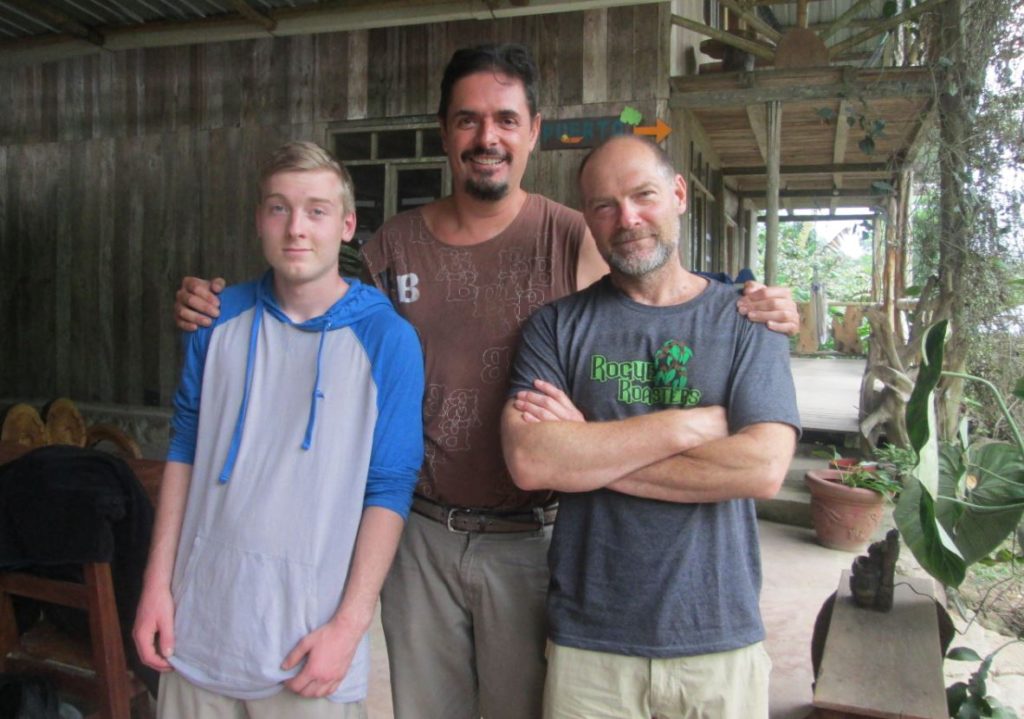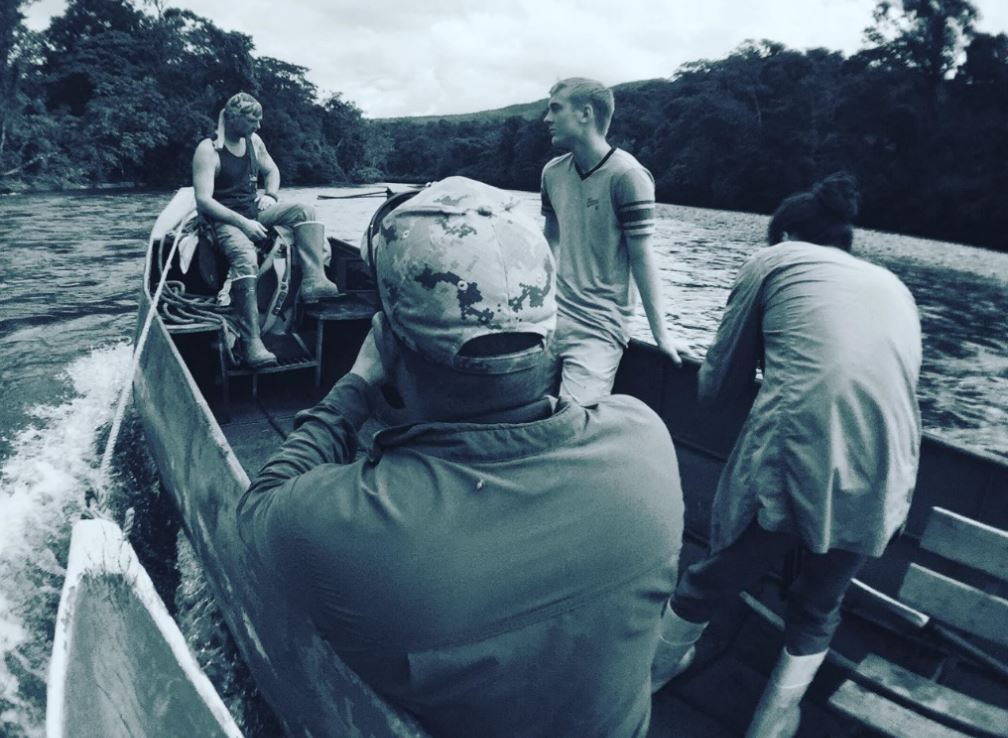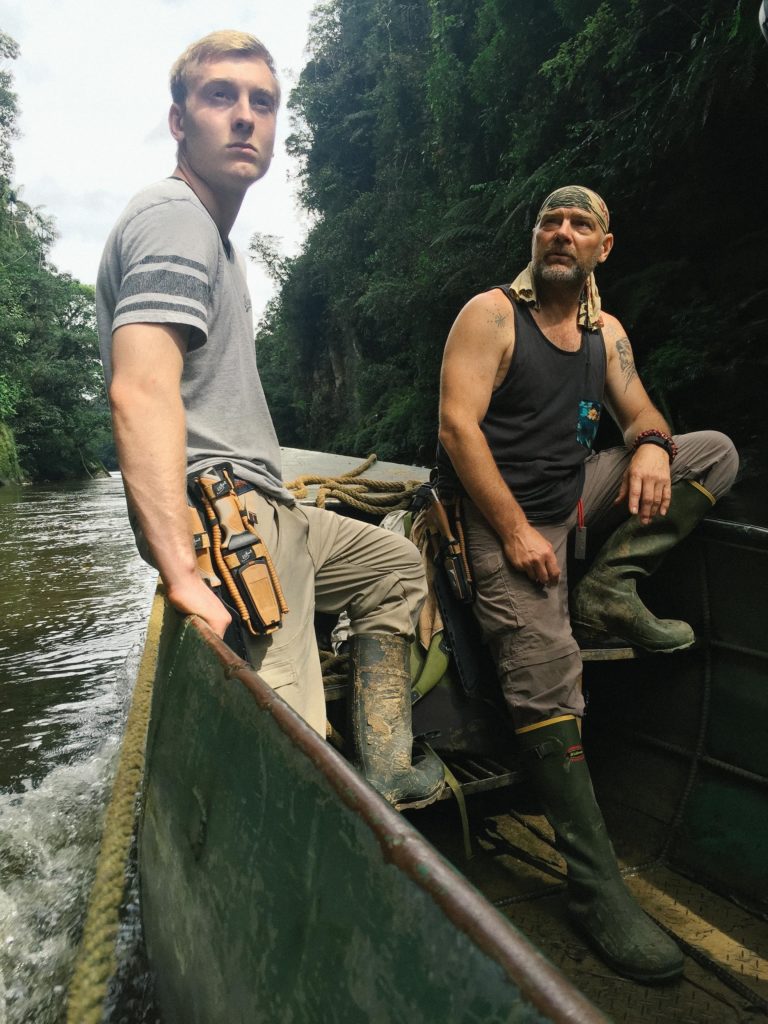Ready to confront poisonous snakes, red ants, extreme heat and humidity, heavy rain, and the challenge of obtaining his own food and fresh water in the wild, Canada’s Les Stroud returned to Ecuador last May, ten years after his last visit, to film another episode of “Survivorman,” this time in Podocarpus National Park, located in the Zamora Chinchipe and Loja provinces. This Discovery Channel program, now known as “Survivorman and Son” because it features his 19 year-old son, Logan, originated the modern nature reality show on television that has become so popular.
This writer had the good fortune to participate both as crew as well observer, and discover what goes on behind the scenes in the production of a series that reaches 120 countries and an audience in the millions.
However, my principle contribution to this episode was not so much “behind the scenes,” as “before the scenes.” Aware of my experience with film and television production in Ecuador, I was contacted by a friend in Vilcabamba who had assisted Les Stroud in his first visit to the country back in 2006. During the filming of that particular episode, Les met with the Huaorani, took part in an Ayahuasca ceremony, and was stalked by a jaguar.
There would be no jaguars this time. Nonetheless, there was a formidable challenge: The bureaucracy of Ecuador. I made an offer; that I would negotiate with all the agencies of the state in exchange for an opportunity to accompany them during the filming, a proposal they readily accepted.
The experienced proved illuminating. For example, when I went to the Customs office in Quito, I was informed that before the Stroud production crew arrived, Customs would need an equipment list — and that they could bring anything except unmanned aerial cameras known as drones. When I relayed this back to the production outfit in Canada, Les Stroud protested, and threatened to relocate the production to Peru. So immediately, therefore, I called the Customs Dispatch Director in Tumbaco, and now it turns out that drones are perfectly fine.
Furthermore, I discovered that the government division known as the National Secretary of Communication would have to approve the script (a challenge, being that documentary film scripts are generally made after shooting, not before), and that in turn, the filming would then need approval by the Ministry of the Exterior, who would then notify Customs, and thus allow them to cancel the duty on the equipment. Unfortunately, I was informed of this particular protocol only hours before the crew was set to arrive at Mariscal Sucre International Airport that Friday evening. Yet once again, I called the Customs Dispatch Director – “no problem,” he told me, duty cancelled.

On their first day in Podocarpus, the crew scouted the Nangaritza River for locations. Meanwhile, I was handed a GoPro camera and asked to film local scenery in the surrounding area, such the cascades, which could be incorporated into the production. I also got an opportunity to squeeze through a labyrinth of caves under enormous petrified tree trunks that could be easily be mistaken for Godzilla feet.
On the fourth day, Les and his son, Logan, but without the crew, took off in a traditional canoe, up the river and camped for three nights. They returned without incident, and enough footage for an episode that will be broadcast in year. Despite their fame and bravery, both Les and Logan came across as regular, down-to-Earth guys; at one point in a conversation with his crew over dinner, he mentioned how much he enjoys the catty exchanges between veteran actresses Maggie Smith and Shirley Maclaine on the British television series, “Downton Abbey.”
And the end of the shoot, Les sat for an interview and talked about the people of Ecuador, his support of the victims of last April’s earthquake, and his take on environmental issues.
Being that this is your second visit to Ecuador, and that you have travelled so much, do you have any unique observations into Ecuador, its culture, and geography?
The Ecuadorian experience, it really does seem like an experience in tenacity when you meet the people and when you see them. There is this depth to this jungle, to this topography that is extreme. You can’t come in here and be casual. Nobody here is overly casual about how they live and how they survive because of the Ecuadorian topography. That is the thing that always sticks out to me. This is tough living, this is not so easy.
Could you tell us a little about your involvement with Shelterbox and how it is helping the victims of the recent earthquake?
Shelterbox is a great organization that attends disaster zones, especially things like earthquakes like we have in Ecuador, and I know they are here. In fact, I am trying to get up to them. I like to work as an ambassador for them, but I am also on deployment for them for some of the training.
Their main goal is to come and handle the immediate, initial, temporary need for shelter. Let’s get roofs over people’s heads, so they can get their lives put back together. And in a disaster like Ecuador with the earthquake, that’s a very appropriate a scenario for Shelterbox to come in here and kick into gear.
With respect to environmental conservation, are there any more conservation efforts you support more than others?
It’s hard. When you start supporting environmental concerns, it’s easy to go onto a thousand tangents; plastic in the ocean, and you want to deal with that. You see something about garbage and recycling, and all of a sudden you want to deal with that.
Of course my heart strings get pulled a lot by creatures, by ocean creatures and land creatures, so I try to work in terms of protecting whales, dolphins and sharks, which is a big one for me. I do a lot of diving, so I would suggest that protecting sharks is very high on my list, but it doesn’t take me very long to get onto the land again, and see the needs there, environmentally, in terms of air pollution.
One is very protected in North America; it seems so clean and benign, even though you can find lots of pollution there, but visit some of these other countries, and you go “oh my gosh,” work needs to be done. I can’t prioritize them, but I certainly spend a lot of time working for the oceans.
And what about that argument that it is either the environment or the economy?
Well, the thing that is an obvious one to a lot of people is that if the environment suffers, the economy is going to suffer. I think an economy that has the environment first is long lasting and will have us all moving into the next hundreds of thousands of years, but the economy that doesn’t care about the environment will turn us into (the movie) “Blade Runner,” and it will turn into a hideous-looking planet, so to me there is no argument between the economy and the enviroment. Without the environment, there is no economy.
Do you have any feelings about all the new nature-themed reality programs inspired by Survivorman?
It is a mixed blessing, or a double-edged sword, however you want to look at it. On the one hand I can say I am very proud of what “Survivorman” spawned in terms of a genre of television. We did spawn something pretty amazing, with hundreds of hundreds of millions of dollars that I don’t see, but I am very proud of a scene my show ripped off on a lot of levels. As a producer, I know where they got that from.
But I do like them? No, I don’t like any of them. The ones that push people to their limits are based on pure entertainment to watch the suffering, and the one’s that try to come across as the next Les fake it all. They set it all up and stage it, because they have to in order to get in all the content. So I don’t admire what they have done with the original idea of Survivorman, yet at the same time, I am kind of proud of how far it has spread. It is a mixed bag
What can you tell us about human nature?
My insights into human nature is that it is as powerful and as beautiful as all of us altruists want to think. We are people everywhere, we all want the same things in life, we want love, we want to be sheltered, and so on. That’s also very true, but on the other hand, another insight is that there is a lot of people out there who don’t care, that don’t give a rip. There is just as many people who don’t care about the environment in Ecuador as there in Bolivia, as there are in Europe, as there are in Toronto, as there are in New York, as there are in Japan. There as just as many people who care deeply about the environment in all of those places as well, so human nature is very much the same everywhere.
I am always quick to deromanticize other world experiences and situations, and we as North Americans come and think we’re the know-it-alls, we’re the first world, we have all the money, we think we show up knowing everything. Well, we’re exactly the same as them. We also tend to think “Oh look at how cute and quaint these people are, how romantic this is.” Well no, some of these people are assholes too, and some of them are really lovely. But human nature is the same place right here in this city as it is sitting in a cafe in Toronto at this very moment. It is just all there.
Have you had any near-death experiences?
In the course of Survivorman, I’ve had two, maybe three really serious circumstances where I’ve got into really serious peril. There has been being chased by a jaguar, obviously in the jungle, hit by a moose with a full set of antlers, and I have been chased by an elk as well. But really, the toughest ones were in Norway, and in Romania, where I was going downhill.
But I must say, the reason I got myself into this tough situation was because I got too comfortable, and that is the way it always happens in survival shows. The minute you feel that, “yeah, you know, I got this.” The minute you have that attitude is the minute you get yourself into trouble, and twice on “Survivorman” I have pushed this a little too far. So Norway going downhill and Romania going downhill, both those times were pretty scary.
What is the longest you have gone without food and water?
Water has been only 48 hours I suppose, and that is tough. Even that is very, very difficult. Without food? About ten days, I guess. That is the longest. That is the answer. About ten days. Dream diet. The Survivorman diet.
The most extreme place I have ever been. I prefer to answer that question by saying it is never about geography, it’s not about location. It does not matter if it is steep or flat. It is all about temperature. Temperature creates the extreme that is the toughest to survive in. But if the question is skewered towards geography. Extreme? That is a hard word to nail. Maybe the jungle here because there are so many poisonous creatures; you are always watching out for ants, whatever is slithering and crawling, there is always something there.
Whereas in other places you don’t have to do that, you can just sit down anywhere you want. Maybe the jungle, but I still say the worst and toughest thing is the cold.
What has been your coldest and snowiest adventure?
Probably the very second Survivorman I ever shot. It was really a pilot. I shot it in the wintertime in nothern Ontario, it was minus 45 degrees. That was absolutely brutal, that was the touhest. And the most snow? Yes. Even though at that temperature, you do not get a lot of snow, there had already been two meters of snow, so that is what it was.
What is your place in the world?
Really hard to nail down. I have seen so many now in all these Survivorman episodes, I would say that the high Andes, I just love. The jungle, I adore, but also the high Canadian artic, but also the Utah canyon lands get a nod. You see, it starts to get hard after awhile because there are so many powerful, beautiful places. Those are my top four, though.
What is the longest you have gone without sleep?
That is hard to say. On a lot of these “Survivorman” episodes I’ll only get 20 minutes here and there. It is very difficult to sleep in these situations. But I am going to say I have gone probably a good, solid three and a half, four days without any sleep at all.
Anywhere you haven’t been yet that you want to visit?
Probably more of the Himalayas. I only touched on their foothills. I want to see the Himalayas. Iceland, Siberia, lots of places to go yet.
So what is the worst thing you have ever eaten?
Watch the “Survivorman Beyond Survival” episode, the episode where I get these tattoos, and I ate a grub there that tasted like a piece of plastic filled with milk that was three weeks old and left in the sun, and it was still moving and alive.
Originally published in Mundo Diners






















